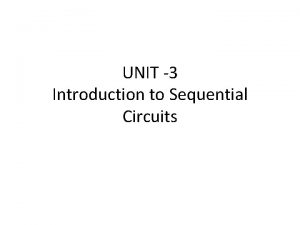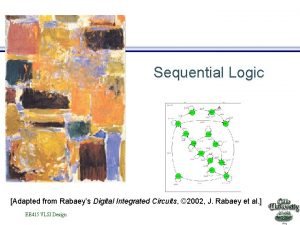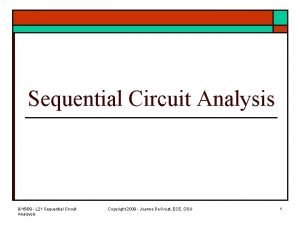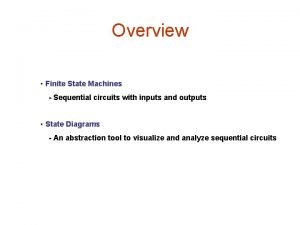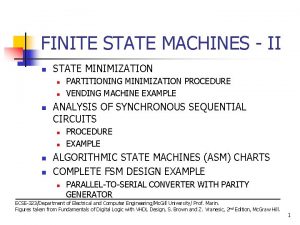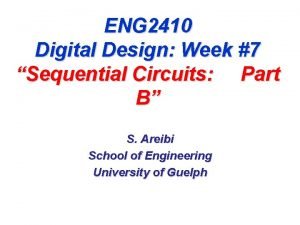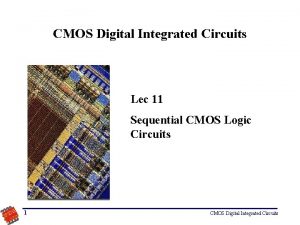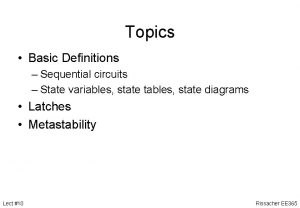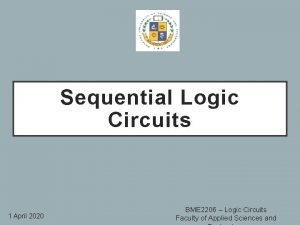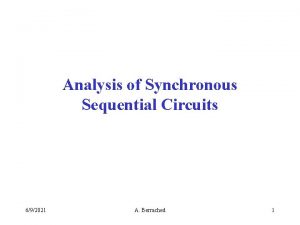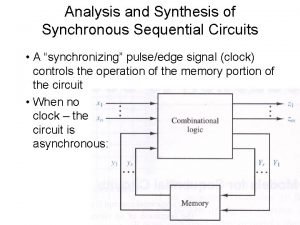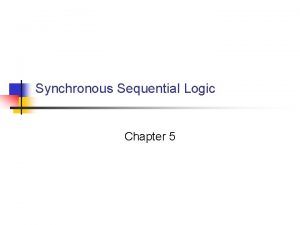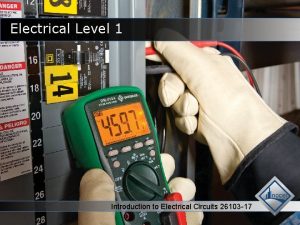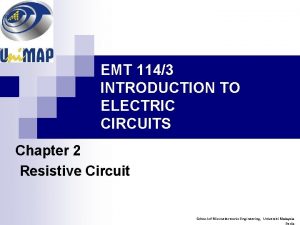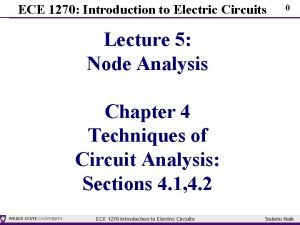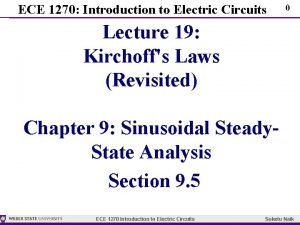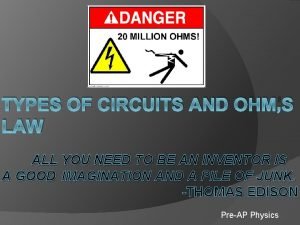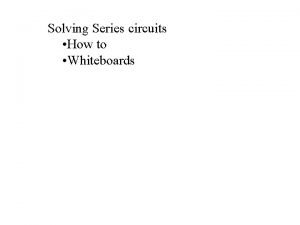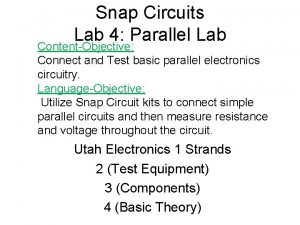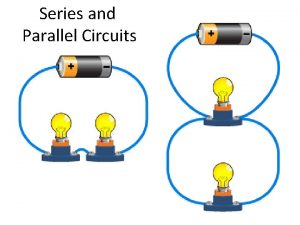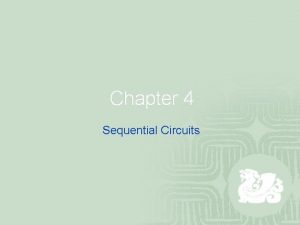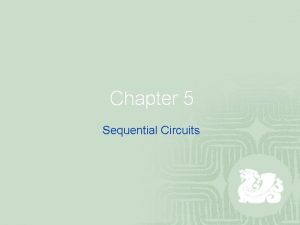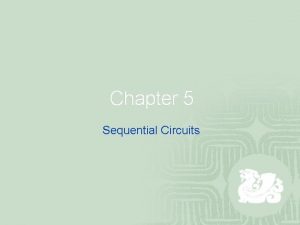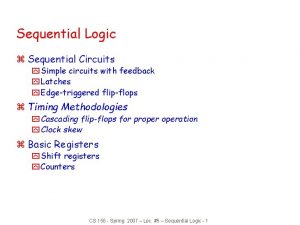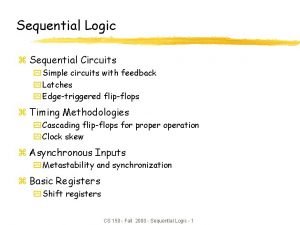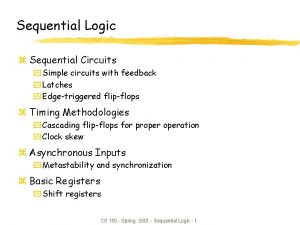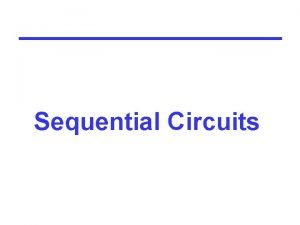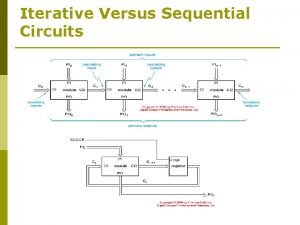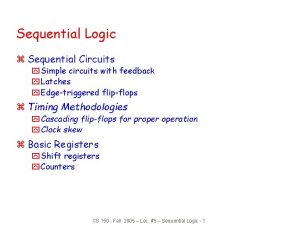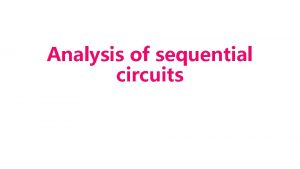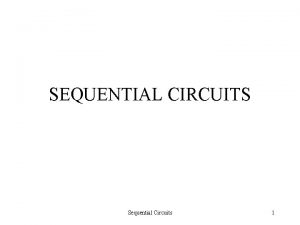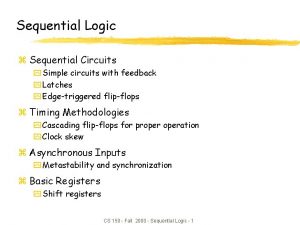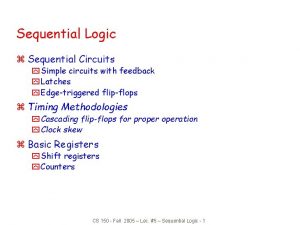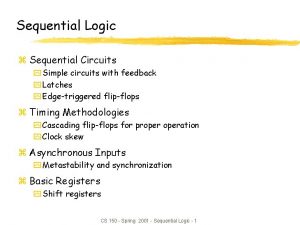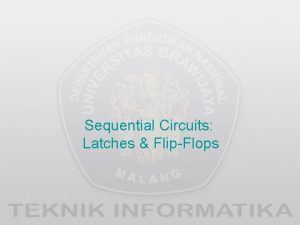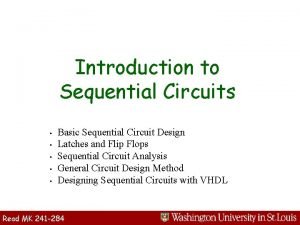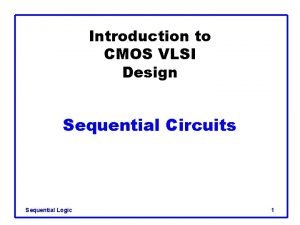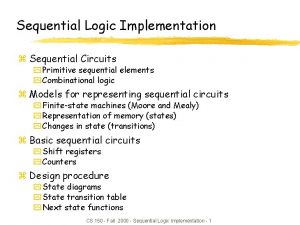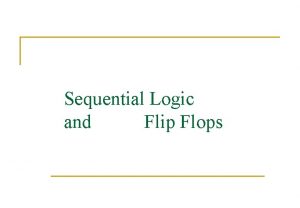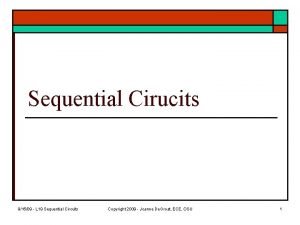UNIT 3 Introduction to Sequential Circuits 3 Sequential





























- Slides: 29

UNIT -3 Introduction to Sequential Circuits

3. Sequential Logic Latches & Flip-flops § Introduction § Memory Elements § Pulse-Triggered Latch v S-R Latch v Gated D Latch § Edge-Triggered Flip-flops v S-R Flip-flop v D Flip-flop v J-K Flip-flop v T Flip-flop § Asynchronous Inputs 2

3. 1 Introduction § A sequential circuit consists of a feedback path, and employs some memory elements. Combinational outputs Memory outputs Combinational logic Memory elements External inputs Sequential circuit = Combinational logic + Memory Elements 3

Introduction cont. . § There are two types of sequential circuits: v synchronous: outputs change only at specific time v asynchronous: outputs change at any time § Multivibrator: a class of sequential circuits. They can be: v bistable (2 stable states) v monostable or one-shot (1 stable state) v astable (no stable state) § Bistable logic devices: latches and flip-flops. § Latches and flip-flops differ in the method used for changing their state. Introduction 4

3. 2 Memory Elements § Memory element: a device which can remember value indefinitely, or change value on command from its inputs. command Memory element Q stored value § Characteristic table: Q(t): current state Q(t+1) or Q+: next state

Memory Elements cont. . . § Memory element with clock. Flip-flops are memory elements that change state on clock signals. command Memory element Q clock § Clock is usually a. Positive square pulses wave. Positive edges Negative edges stored value

Memory Elements cont. . § Two types of triggering/activation: v pulse-triggered v edge-triggered § Pulse-triggered v latches v ON = 1, OFF = 0 § Edge-triggered v flip-flops v positive edge-triggered (ON = from 0 to 1; OFF = other time) v negative edge-triggered (ON = from 1 to 0; OFF = other time)

3. 2 S-R Latch § Complementary outputs: Q and Q'. § When Q is HIGH, the latch is in SET state. § When Q is LOW, the latch is in RESET state. § For active-HIGH input S-R latch (also known as NOR gate latch), R=HIGH (and S=LOW) a RESET state S=HIGH (and R=LOW) a SET state both inputs LOW a no change both inputs HIGH a Q and Q' both LOW (invalid)!

S-R Latch cont. . § For active-LOW input S'-R' latch (also known as NAND gate latch), R'=LOW (and S'=HIGH) a RESET state S'=LOW (and R'=HIGH) a SET state both inputs HIGH a no change both inputs LOW a Q and Q' both HIGH (invalid)! § Drawback of S-R latch: invalid condition exists and must be avoided.

S-R Latch cont. . § Characteristics table for active-high input S-R latch: S Q R Q' § Characteristics table for active-low input S'-R' latch: S Q R Q'

S-R Latch cont. . § Active-HIGH input S-R latch 10 100 R Q 11000 10 001 S Q' 0 0 1 1 0 § Active-LOW input S’-R’ latch S' Q R' Q' S' Q Q' R' S-R Latch

3. 3 Gated S-R Latch § S-R latch + enable input (EN) and 2 NAND gates gated S-R latch. S Q EN Q' S EN R Q Q' R Gated S-R Latch 12

Gated S-R Latch cont. . § Outputs change (if necessary) only when EN is § § HIGH. Under what condition does the invalid state occur? Characteristic table: EN=1 Q(t+1) = S + R'. Q S. R = 0 Gated S-R Latch 13

3. 4 Gated D Latch § Make R input equal to S' gated D latch. § D latch eliminates the undesirable condition of invalid state in the S-R latch. D Q EN Q' Gated D Latch D EN Q Q' 14

Gated D Latch cont. . § When EN is HIGH, v D=HIGH latch is SET v D=LOW latch is RESET § Hence when EN is HIGH, Q ‘follows’ the D (data) § input. Characteristic table: When EN=1, Q(t+1) = D Gated D Latch 15

3. 5 Latch Circuits: Not Suitable § Latch circuits are not suitable in synchronous logic § § § circuits. When the enable signal is active, the excitation inputs are gated directly to the output Q. Thus, any change in the excitation input immediately causes a change in the latch output. The problem is solved by using a special timing control signal called a clock to restrict the times at which the states of the memory elements may change. This leads us to the edge-triggered memory elements called flip-flops. Gated D Latch 16

3. 6 Edge-Triggered Flip-flops § Flip-flops: synchronous bistable devices § Output changes state at a specified point on a § triggering input called the clock. Change state either at the positive edge (rising edge) or at the negative edge (falling edge) of the clock signal. Clock signal Positive edges Negative edges Edge-Triggered Flip-flops 17

Edge-Triggered Flip-flops cont. . § S-R, D and J-K edge-triggered flip-flops. Note the “>” symbol at the clock input. S C R Q D C Q' Q Q' J C K Q Q' Positive edge-triggered flip-flops S C R Q D C Q' Q' Negative edge-triggered flip-flops Edge-Triggered Flip-flops 18

3. 7 S-R Flip-flop § S-R flip-flop: on the triggering edge of the clock pulse, v S=HIGH (and R=LOW) a SET state v R=HIGH (and S=LOW) a RESET state v both inputs LOW a no change v both inputs HIGH a invalid § Characteristic table of positive edge-triggered S-R flip-flop: X = irrelevant (“don’t care”) = clock transition LOW to HIGH SR Flip-flop 19

S-R Flip-flop cont. . § It comprises 3 parts: v a basic NAND latch v a pulse-steering circuit v a pulse transition detector (or edge detector) circuit § The pulse transition detector detects a rising (or falling) edge and produces a very short-duration spike. SR Flip-flop 20

S-R Flip-flop cont. . The pulse transition detector. S Pulse transition detector CLK Q' R CLK' CLK Q CLK* CLK' CLK* CLK CLK' CLK* Positive-going transition (rising edge) SR Flip-flop Negative-going transition (falling edge) 21

3. 8 D Flip-flop § D flip-flop: single input D (data) v D=HIGH a SET state v D=LOW a RESET state § Q follows D at the clock edge. § Convert S-R flip-flop into a D flip-flop: add an inverter. D CLK S C R Q Q' A positive edge-triggered D flip-flop formed with an S-R flip-flop. D Flip-flop = clock transition LOW to HIGH 22

D Flip-flop cont. . § Application: Parallel data transfer. To transfer logic-circuit outputs X, Y, Z to flipflops Q 1, Q 2 and Q 3 for storage. D CLK X Combinational logic circuit Y D Z CLK D Transfer CLK Q Q 1 = X* Q' Q Q 2 = Y* Q' Q Q 3 = Z* Q' * After occurrence of negative-going transition D Flip-flop 23

3. 9 J-K Flip-flop § J-K flip-flop: Q and Q' are fed back to the pulse§ § steering NAND gates. No invalid state. Include a toggle state. v J=HIGH (and K=LOW) a SET state v K=HIGH (and J=LOW) a RESET state v both inputs LOW a no change v both inputs HIGH a toggle J-K Flip-Ffop 24

J-K Flip-flop cont. . § J-K flip-flop. J CLK K Pulse transition detector Q Q' § Characteristic table. Q(t+1) = J. Q' + K'. Q J-K Flip-flop 25

3. 10 T Flip-flop § T flip-flop: single-input version of the J-K flip flop, formed by tying both inputs together. T CLK T Q Pulse transition detector CLK Q' J C K Q Q' § Characteristic table. Q(t+1) = T. Q' + T'. Q T Flip-flop 26

T Flip-flop cont. . § Application: Frequency division. High J CLK High J Q CLK C K CLK Q QA QA J C C K K QB QB Divide clock frequency by 2. Divide clock frequency by 4. § Application: Counter (to be covered in Lecture 13. ) T Flip-flop 27

3. 11 Asynchronous Inputs § S-R, D and J-K inputs are synchronous inputs, as § § data on these inputs are transferred to the flipflop’s output only on the triggered edge of the clock pulse. Asynchronous inputs affect the state of the flip-flop independent of the clock; example: preset (PRE) and clear (CLR) [or direct set (SD) and direct reset (RD)] When PRE=HIGH, Q is immediately set to HIGH. When CLR=HIGH, Q is immediately cleared to LOW. Flip-flop in normal operation mode when both PRE and CLR are LOW. Asynchronous Inputs 28

Asynchronous Inputs cont. . § A J-K flip-flop with active-LOW preset and clear inputs. PRE J C K Q J CLK Q' K Q Pulse transition detector Q' CLR CLK PRE J = K = HIGH CLR Q Preset Asynchronous Inputs Toggle Clear 29
 Introduction to sequential circuits
Introduction to sequential circuits Series parallel circuit current
Series parallel circuit current Non bistable sequential circuits
Non bistable sequential circuits Sequential circuit analysis
Sequential circuit analysis Contoh rangkaian sekuensial
Contoh rangkaian sekuensial Finite state machine sequential circuits
Finite state machine sequential circuits Finite
Finite Analysis of sequential circuits
Analysis of sequential circuits Non bistable sequential circuits
Non bistable sequential circuits Sequential circuits prelude
Sequential circuits prelude Sequential circuits
Sequential circuits State diagram
State diagram Analysis of synchronous sequential circuits
Analysis of synchronous sequential circuits State diagram
State diagram Mealy moore
Mealy moore Nnj
Nnj Nccer introduction to electrical circuits
Nccer introduction to electrical circuits Introduction to electric circuits
Introduction to electric circuits Introduction to electric circuits
Introduction to electric circuits Introduction to electric circuits
Introduction to electric circuits Unit 6 review questions
Unit 6 review questions Lesson outline lesson 3 describing circuits answers
Lesson outline lesson 3 describing circuits answers A switch in a datagram network uses
A switch in a datagram network uses Types of circuits and ohm's law
Types of circuits and ohm's law Babinski sign
Babinski sign Isolated instrumentation amplifier
Isolated instrumentation amplifier Solving series circuits
Solving series circuits Snap circuit lab
Snap circuit lab Series vs parallel diagram
Series vs parallel diagram How to find req in a series circuit
How to find req in a series circuit
